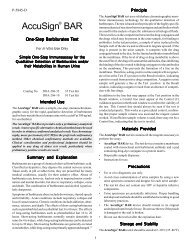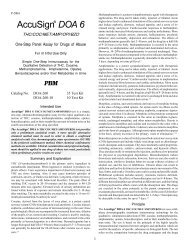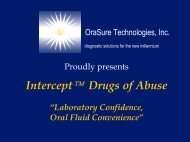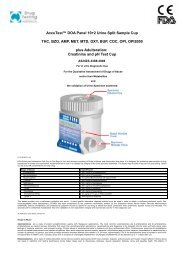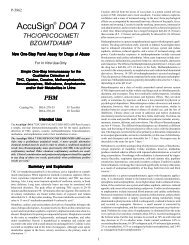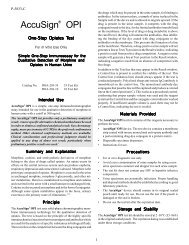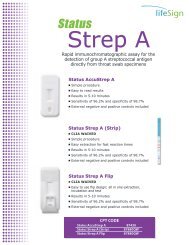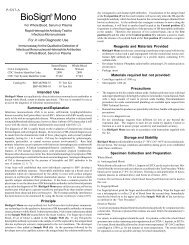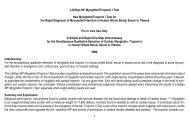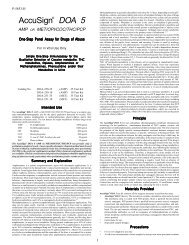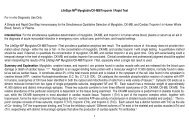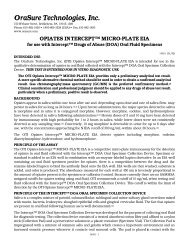AccuTest DOA Panel 9+2 Urine Split Sample Cup - Drug Testing
AccuTest DOA Panel 9+2 Urine Split Sample Cup - Drug Testing
AccuTest DOA Panel 9+2 Urine Split Sample Cup - Drug Testing
Create successful ePaper yourself
Turn your PDF publications into a flip-book with our unique Google optimized e-Paper software.
<strong>Urine</strong>Check: Adulteration Test(s)<br />
Semi-quantitative results are obtained by visually comparing the color of each pad with the corresponding test color chart provided or below.<br />
LIMITATION OF PROCEDURE<br />
The assay is designed for use with human urine only. A positive result with any of the tests indicates only the presence of a drug/metabolite and does not indicate or measure<br />
intoxication. There is a possibility that technical or procedural error as well other substances in certain foods and medicines may interfere with the test and cause false results.<br />
Please refer “SPECIFICITY” section for lists of substances that will produce either positive results, or that do not interfere with test performance. If a drug/metabolite and/or Alcohol<br />
is/are found present in the urine specimen, the assay does not indicate frequency of drug and/or alcohol use or distinguish between certain foods and medicines and drug of abuse,<br />
or alcohol.<br />
Special limitation of Procedure for Adulteration test<br />
Comparison to the color chart is dependent on the interpretation of the individual. It is therefore, recommended that all laboratory personnel interpreting the results of these strips be<br />
tested for color blindness.<br />
EXPECTED RESULTS<br />
<strong>Drug</strong>s of Abuse<br />
<strong>Drug</strong>s of Abuse test is a qualitative assay. It identifies the drug(s) in human urine at its cut-off concentration or higher. The concentration of the drug(s) can not be determined by this<br />
assay. The test is intended to distinguish negative result from presumptive positive result. All positive results must be confirmed using an alternate method, preferably GC/MS.<br />
Adulteration Test<br />
Creatinine: Daily Creatinine excretion, related to muscle mass of the human body, is usually constant. The DOT guideline states that urine specimens with Creatinine levels of<br />
less than 20mg/dl are indications of adulteration. Although these ranges are affected by age, sex, diet, muscle mass and local population distribution, sample with Creatinine level<br />
of lower than 20mg/dl should be considered adulterated.<br />
pH: Normal urine pH ranges from 4.5 to 8.0. Values below pH 4.0 or above pH 9.0 are indicative of adulteration.<br />
PERFORMANCE CHARACTERISTICS<br />
A. Accuracy<br />
The accuracy of the <strong>DOA</strong> test panels were evaluated in each component strip and in comparison to GC/MS method at the following concentration: d-amphetamine 300ng/ml (AMP),<br />
oxazepam, 200 ng/ml (BZO), buprenorphine-3-β-d-glucoronide 10ng/ml (BUP), benzoylecgonine 300ng/ml (COC), methadone 300 ng/ml (MTD), (+)methamphetamine 300 ng/ml<br />
(MET), morphine 300 ng/ml (OPI), oxycodone 100ng/ml (OXY), and 11-nor-∆ 9 -THC-9-COOH 50 ng/ml (THC). The results of each component strip are listed below:<br />
1. Amphetamine The accuracy of the amphetamine test was evaluated in comparison to GC/MS method at a cut-off of 300 ng/ml. Eighty one (81) urine specimens with GC/MS<br />
confirmed d-amphetamine concentration were evaluated in this study. The results are summarized and presented below:<br />
Positive % agreement: 92, Negative % agreement: 98<br />
Four specimens were found discrepant between the RapidAMP and the GC/MS method. When compared those data, 50% (2 out of 4) of the discrepancy specimens were found<br />
between +25% to –25% of cutoff concentration (225-375 ng/ml).<br />
2. Benzodiazepine The accuracy of the benzodiazepine test was evaluated in comparison to GC/MS at a cut-off of 200 ng/ml of oxazepam. Seventy nine (79) urine specimens with<br />
GC/MS confirmed oxazepam concentration were evaluated in this study. The results are summarized and presented below:<br />
Positive % agreement: 97, Negative % agreement: 100<br />
One specimen was found discrepant between the Rapid BZD and GC/MS method. When compared those data, it was found to be between –25% and +25% cut-off concentration<br />
( 150 – 250 ng/ml ).<br />
3. Buprenorphine The accuracy of the Buprenorphine test was evaluated in comparison to GC/MS at a cut-off of 10 ng/ml of buprenorphine-3-β-d-glucoronide. One hundred and<br />
one (101) urine specimens with confirmed buprenorphine-3-β-d-glucoronide concentrations were evaluated in this study. Borderline readings were recorded as negative. The results<br />
are summarized and presented below:<br />
Positive % agreement: 96, Negative % agreement: 100.<br />
Two specimens were found discrepant between the Rapid BUP and GC/MS method. When compared those data, 50% (1out of 2) of the discrepancy specimens were found between<br />
-25% cut-off and cut-off concentration (7.5 – 10 ng/ml).<br />
4. Cocaine The accuracy of the cocaine test was evaluated in comparison to GC/MS at a cut-off of 300 ng/ml of benzoylecgonine. Eighty one (81) urine specimens with GC/MS<br />
confirmed benzoylecgonine concentration were evaluated in this study. The results are summarized and presented below:<br />
Positive % agreement: 94, Negative % agreement: 100<br />
Two specimens were found discrepant between the Rapid COC and GC/MS method. When compared those data, 100% (2 out of 2 ) of the discrepancy specimens were found<br />
between –25% and +25% cut-off concentration (225 – 375 ng/ml).<br />
5. Methadone The accuracy of the Rapid MTD test was evaluated in comparison to GC/MS at a cut-off of 300 ng/ml of methadone. One hundred and nineteen urine specimens with<br />
confirmed methadone concentrations were evaluated in this study. The results are summarized and presented below:<br />
Positive % agreement: 98.3, Negative % agreement: 98.3.<br />
Two specimens were found discrepant between the Rapid MTD and GC/MS method. When compared those data, 100% (2 out of 2) of the discrepancy specimens were found<br />
between –25% and +25% cut-off concentration (225 – 375 ng/ml).<br />
6. Methamphetamine The accuracy of the methamphetamine test was evaluated in comparison to GC/MS at a cut-off of 300 ng/ml of (+)methamphetamine. Eighty (80) urine<br />
specimens with GC/MS confirmed (+)methamphetamine concentration were evaluated in this study. The results are summarized and presented below:<br />
Positive % agreement: 95, Negative % agreement: 100<br />
Two specimens were found discrepant between the Rapid MET and GC/MS method. When compared those data, 100% (2 out of 2 ) of the discrepancy specimens were found<br />
between –25% and cut-off concentration ( 225 – 375 ng/ml ).<br />
7. Opiate The accuracy of the opiates test was evaluated in comparison to GC/MS at a cut-off of 300 ng/ml of morphine. One hundred and twenty three urine specimens with GC/MS<br />
confirmed morphine and codeine concentrations were evaluated in this study. The results are summarized and presented below:<br />
Positive % agreement: 97.4, Negative % agreement: 91.3<br />
Six specimens were found discrepant between the Rapid OPI and GC/MS method. When compared those data, 50% (3 out of 6 ) of the discrepancy specimens were found between<br />
–25% and +25% cut-off concentration<br />
( 225 – 375 ng/ml ).<br />
8. Oxycodone The accuracy of the oxycodone test was evaluated in comparison to GC/MS method at a cut-off of 100 ng/ml. One hundred and forty urine specimens with GC/MS<br />
confirmed oxycodone concentration were evaluated in this study. The results are summarized and presented below:<br />
Positive % agreement: 100, Negative % agreement: 95<br />
Four specimens were found discrepant between Rapid OXY and the GC/MS method. When compared those data, 75% (3 out of 4) of the discrepancy specimens were found<br />
between cut-off and +25% of cutoff concentration (100-125 ng/ml).<br />
9. THC The accuracy of the THC test was evaluated in comparison to GC/MS at a cut-off of 50 ng/ml of 11-nor-∆ 9 -THC-9-COOH. Eighty eight (88) urine specimens with GC/MS<br />
confirmed 11-nor-∆ 9 -THC-9-COOH concentrationwere evaluated in this study. The results are summarized and presented below:



